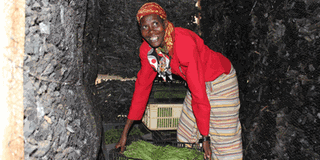Our charcoal cooler keeps produce fresh

Mary Gatumitha one of the French bean farmers stores her produce in the fridge. PHOTO | PAULINE KAIRU
What you need to know:
- Using charcoal, a wire mesh and a water tank, the women have made an innovative fridge, which they use to store their produce for export market.
- The pipes are fed with water from an overhead tank. The water continuously drips as it happens in a drip irrigation system, all the way to the bottom of the charcoal wall.
- Since there is a constant breeze in Isiolo and the evaporative cooling devices work most efficiently in windy and dry conditions, according to Mutie, this makes the fridge effective.
Necessity is the mother of invention, so goes the saying. This proverb captures the experiences of Bidii Farmers Group in the arid Kambi Sheikh Village in Isiolo County.
The women’s group has come up with an innovative way to preserve their French beans.
With temperatures in the area rising to over 30 degrees Celsius, their French beans would rot before getting to the market due to the bad weather.
But gone are the days when they would be stranded with tonnes of rotten French beans.
Using charcoal, a wire mesh and a water tank, the women have made an innovative fridge, which they use to store their produce for export market.
The beans can stay in the fridge for as long as one week, explains Catherine Wanja, a group member.
Catherine says they were first introduced to the idea of growing French beans for export by ActionAid Australia, an international NGO, which seeks to alleviate poverty in marginalised communities.
At first, they did not see how growing the crop was going to work given the distance from the market and the bad climatic conditions. But when the idea of the fridge was introduced, they could not let the opportunity pass.
The cooler, which is placed in a bigger structure used for sorting and grading the French beans, is made from charcoal filled in between six-inch cavity with double wire mesh walls.
The roof is made of iron sheets and is also filled with charcoal. It has a network of perforated water pipes going round the top of the charcoal walls.
The pipes are fed with water from an overhead tank. The water continuously drips as it happens in a drip irrigation system, all the way to the bottom of the charcoal wall.
Charcoal is an ideal material for refrigeration because it has pores, which absorb and store water. This reduces heat from outside. And because wet charcoal does not allow easy passage of heat, it results in low temperatures inside the cubicle.
The fridge is also made of wood, which by nature does not transmit heat, explains Jamleck Mutie, ActionAid’s project officer for Isiolo.
He adds that cooling occurs when a fluid changes state from liquid to vapour or when there is evaporation. As the warm, dry air flows through the moist charcoal, water evaporates into air and it is cooled inside the room.
But he says the cooler must also be protected from direct sunlight, otherwise the surface absorbs ultra violet rays and warms up, making it ineffective.
Since there is a constant breeze in Isiolo and the evaporative cooling devices work most efficiently in windy and dry conditions, according to Mutie, this makes the fridge effective.
“Temperatures in the fridge drop as low as eight degrees Celsius. Their French beans thus stay fresh and do not shrink in weight,” says Mutie.
Wanja says the fridge has a capacity of 20 crates. “Today if the canter that collects the French beans does not come, we are confident that we will not make losses,” she says.
“It is a simple technology that is working for us because we do not have electricity here and we cannot buy a conventional fridge.”




